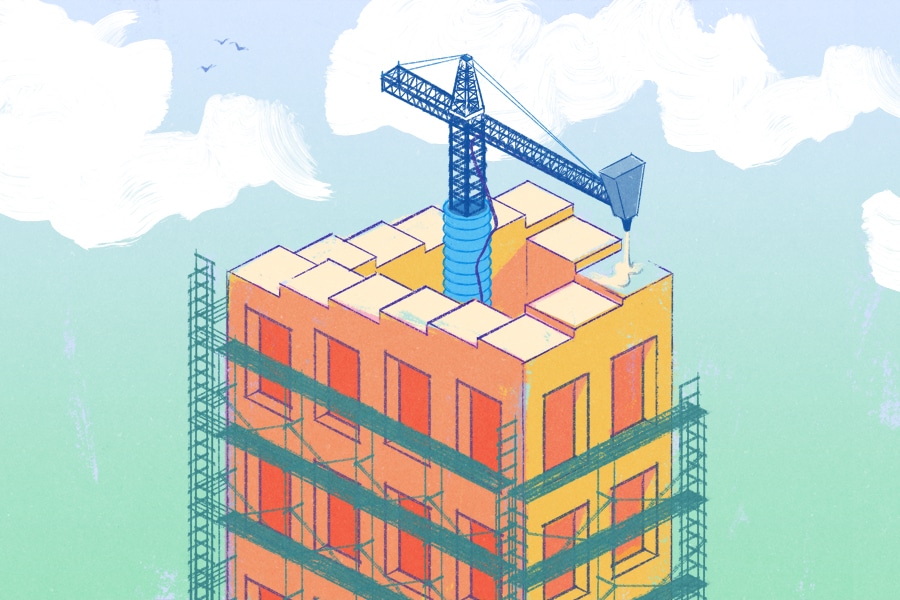Illustration by Jonny Ruzzo
Wince every time you see wasted lumber when prices tripled last year? Wondering how to meet deadlines if there aren’t enough workers on hand?
Maybe it’s time to look at 3D printing.
More formally known as additive manufacturing, 3D printing refers to a set of technologies that make objects by depositing bits of material to make a whole. Often associated with hobbyists and experimenters, the modern state of 3D printing is as far from that as a machining shop is removed from someone whittling with a pen knife.
Printers can create complex forms—literally like rocket engine parts—that might not be possible to create with the subtractive and joining methods of traditional construction. Designers and builders have been experimenting with 3D printing and, at this point, some can turn out entire 3D-printed houses.
“It’s 3D synthetic stone that cures with light,” said Sam Ruben, chief sustainability officer and co-founder of Mighty Buildings, a company that uses massive 3D printers to create panelized houses that are assembled on sites in California.
“Our current 3D component is an empty honeycomb to pour insulation into” with insulative values of up to R27, Ruben said, adding that the material has four times the insulation capabilities of concrete but at a quarter of the physical weight. He claims that one of the company’s fiber reinforcement beams has 20 times the tensile strength, equal or double compression strength and a quarter of the weight of standard reinforced concrete beams.
Differing approaches
There are other companies using different 3D approaches, like Apis Cor, which employs robot arms to distribute concrete mortar. Its system recently built a 31-foot-tall structure in Dubai and was able to print a home in 24 hours for just $10,134.
“The classic problem architects and builders have faced for years is interpretation of drawings,” said Jason Van Nest, a New York City licensed architect and tenure-track professor at NYIT School of Architecture and Design. “This 400-year-old technology of projecting a 3D design onto a piece of paper and handing to someone else [to construct] is a step that architects don’t like.”
MORE ON TECH ADOPTION:
Human errors can cause waste and results that don’t fully match the architect’s intent. But 3D printing, working from 3D computer models, could cure much of this. “Because the labor is automated, there are far reduced mistakes and cost overruns,” Van Nest said.
With 3D printing, “we can be allowed much more strict tolerances at no extra costs,” Van Nest said. “We can have a lot of reliability in inserting cabinetry in the gap between structural walls. 3D printing technology is very seductive, from the ability to generate real design just from our computer models to the reliability of that technology.”
Various roles in building
Additive manufacturing can play many roles in construction and design. Forte Specialty Contractors, for instance, uses 3D design and printing, but in a different way. On the design end, the company constructs a 3D computer model and then prints out quarter-scale 3D printed models of any complex sections—”maybe an interior piece and an exterior piece and [we] put it together as a mock-up,” said CEO Scott Acton. “Standard stuff we’re not going to deal with. Other stuff we [3D print] to make sure we don’t run into issues in the field and delay our process.”
Once the design is set, machines press sheet metal into studs with all cut-outs in place. “We can do five stories, multi-families, no structural steel, right out of the machine,” Acton said. “And it’s all non-combustible. This process has cut off a year from the time frame.”
Architects and builders can also use 3D printing for specific parts, giving themselves time to work up to larger scale uses.
Aline Architecture Concepts in Scottsdale, Arizona, has been using recycled plastic to make wall tiles. “We can print a 6-inch by 6-inch or 12-inch by 12-inch in a few minutes,” said Principal Brian Laubenthal. “We’re currently in construction on a brewery in Phoenix. We’re using them as a feature wall. It’s a test project.”
Aline will see how it performs and then make changes as necessary. The future of 3D printing might include paving sections for a patio or a finished material to mount on exterior walls.
“We’re big on using printed technology and know whether it’s going to be 3D printing or programs like this; eventually our construction drawings are going to be sent to a factory that inputs it and makes it,” Laubenthal said. “It will be a more seamless approach.”











